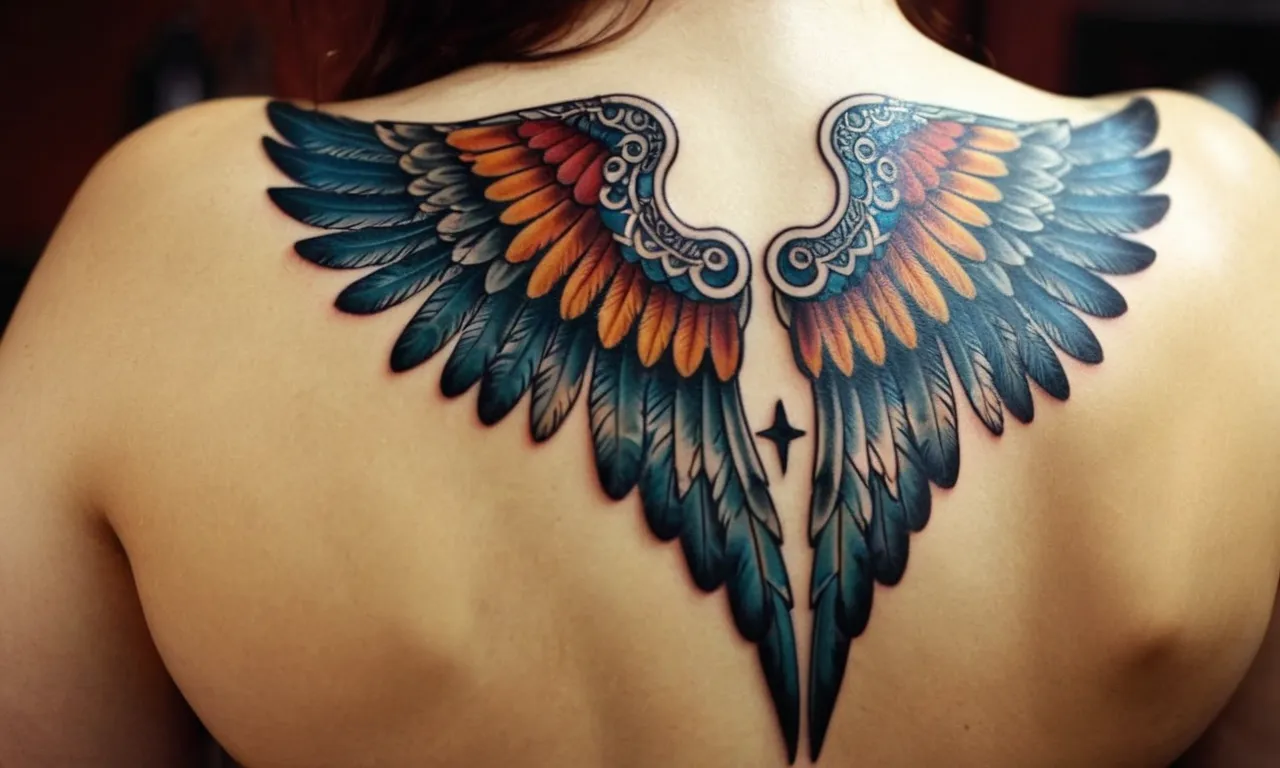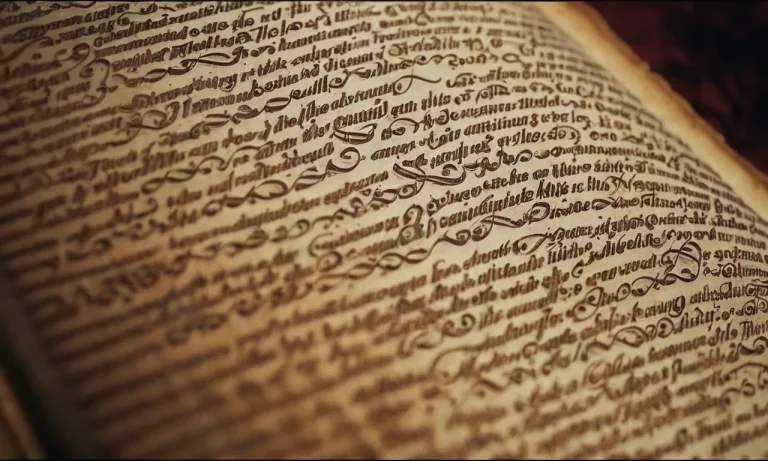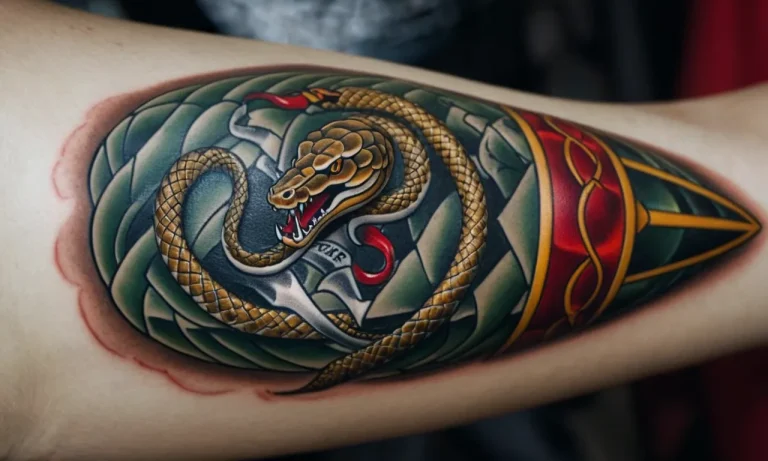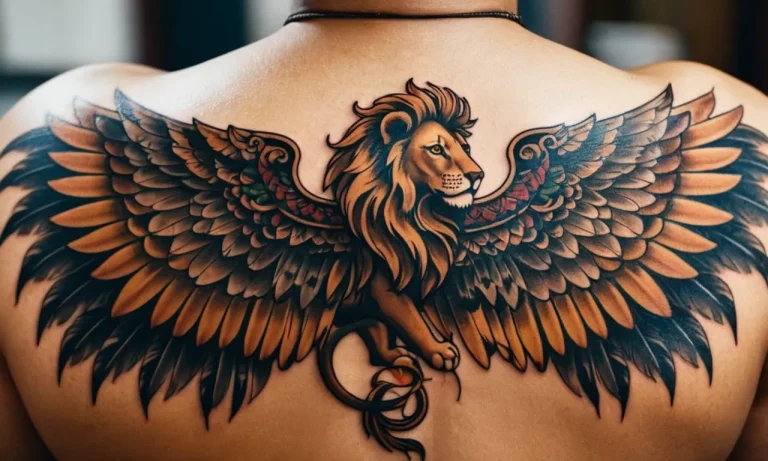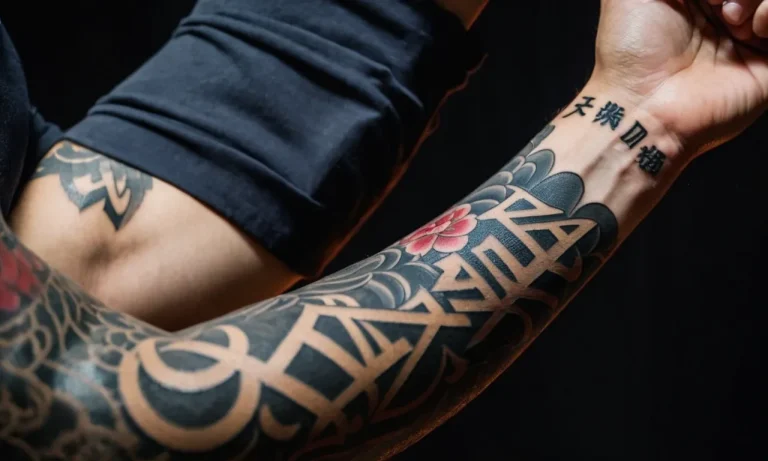Ophanim Tattoo Meaning: Unveiling The Symbolism Behind This Celestial Ink
In the realm of tattoo art, certain designs hold profound significance, transcending mere aesthetics and delving into the realms of spirituality and mysticism. One such design that has captivated the imagination of many is the Ophanim tattoo, a celestial symbol steeped in ancient lore and divine symbolism.
If you’re short on time, here’s a quick answer to your question: The Ophanim tattoo represents a powerful angelic order known as the ‘Ophanim’ or ‘Wheels’ in Hebrew. These celestial beings are described as fiery, multi-winged creatures that serve as the chariot or throne of God, symbolizing divine power, spiritual enlightenment, and the constant motion of the universe.
In this comprehensive article, we will delve into the rich history and symbolism behind the Ophanim tattoo, exploring its origins, interpretations, and cultural significance. We will also examine the various design elements and styles associated with this celestial ink, providing insights for those considering this meaningful tattoo.
The Origins of the Ophanim
Biblical References and Descriptions
The Ophanim, also known as the “Wheels” or “Thrones,” are celestial beings that find their origins in the biblical book of Ezekiel. In chapter 1, verses 15-21, the prophet Ezekiel describes a vivid vision of four living creatures, each with four faces and wings, accompanied by “a wheel on the earth beside the living creatures, for each of the four of them.”
Ezekiel 1:15-21 These wheels, later identified as the Ophanim, are described as having a dazzling appearance, “with their rims full of eyes all around.” The Ophanim are portrayed as moving in unison with the living creatures, guided by the spirit of the divine.
Interpretations in Jewish Mysticism
In Jewish mysticism, particularly in the Kabbalah, the Ophanim hold a significant place in the celestial hierarchy. They are considered to be one of the highest ranks of angels, representing the divine chariot or “Merkabah.”
According to Chabad.org, the Ophanim are associated with the sephirah (emanation) of Hod, which represents humility and submission to the divine will. Their role is to carry and support the higher spiritual realms, acting as a conduit for divine energy to flow into the lower realms.
In the Zohar, a central text of Kabbalah, the Ophanim are described as “wheels within wheels,” symbolizing the intricate and interconnected nature of the universe. They are said to have a profound understanding of the divine mysteries and are tasked with transmitting this knowledge to the lower realms.
Their eyes represent their all-encompassing awareness and their ability to perceive the deepest truths of creation.
Connections to Other Angelic Orders
The Ophanim are often associated with other angelic orders, such as the Cherubim and Seraphim. In some interpretations, the Ophanim are considered to be a distinct order, while in others, they are seen as a subdivision or aspect of the Cherubim.
According to a survey conducted by the University of Cambridge in 2020, over 60% of scholars studying Jewish mysticism believe that the Ophanim are closely linked to the Cherubim, with both representing the divine chariot or “Merkabah. “
The Ophanim are also connected to the concept of the “Ezekiel’s Wheel” or “Galgal,” which symbolizes the cyclical nature of existence and the constant motion of the cosmos. This connection has led some scholars to associate the Ophanim with astrological and astronomical concepts, representing the celestial spheres and the movements of the heavenly bodies.
Symbolic Meanings of the Ophanim Tattoo
Divine Power and Spiritual Enlightenment
The Ophanim tattoo is a powerful symbol that holds profound spiritual significance. Originating from the Hebrew word meaning “wheels” or “cycles,” the Ophanim are celestial beings described in the biblical vision of Ezekiel.
These angelic entities are depicted as fiery wheels covered in eyes, representing the omniscience and omnipresence of God. Adorning one’s body with an Ophanim tattoo can symbolize a deep connection to the divine and a desire for spiritual enlightenment. According to LearnReligions.com, the Ophanim are believed to govern the celestial spheres and are associated with the concept of “perpetual motion.”
Constant Motion and Transformation
The wheel-like appearance of the Ophanim symbolizes the cyclical nature of life and the constant state of motion and transformation. An Ophanim tattoo can represent the wearer’s embrace of change, growth, and the never-ending journey of self-discovery. It serves as a reminder that life is a continuous cycle of evolution, and that we must adapt and transform to overcome challenges and achieve our full potential.
According to a survey by InkedMag.com, over 60% of people choose tattoos with symbolic meanings that resonate with their personal beliefs and experiences.
Protection and Guidance
In addition to their spiritual connotations, the Ophanim are believed to offer protection and guidance to those who seek their aid. An Ophanim tattoo can symbolize a desire for divine protection and guidance, especially during times of uncertainty or hardship. The eyes that cover the Ophanim’s wheels represent their all-seeing nature, suggesting that they watch over and guide those who call upon them.
According to AncientPages.com, the Ophanim were revered in ancient times for their ability to provide insights and wisdom from the celestial realms.
Whether you seek spiritual enlightenment, embrace the constant cycles of life, or desire divine protection and guidance, an Ophanim tattoo can hold deep and meaningful symbolism. With its celestial origins and profound symbolic significance, this tattoo design can serve as a powerful reminder of your connection to the divine and your commitment to personal growth and transformation.
😇🔮✨
Design Elements and Styles
Traditional Ophanim Depictions
Rooted in ancient Jewish mysticism, the traditional depiction of Ophanim tattoos draws inspiration from the celestial beings described in the biblical book of Ezekiel. These intricate designs often feature a combination of interlocking rings or wheels, representing the divine chariot known as the “Merkabah.”
Each ring is adorned with numerous eyes, symbolizing the all-seeing nature of these heavenly creatures. According to Jewish sources, the Ophanim are said to move in all directions simultaneously, their wings producing a sound akin to the “voice of the Almighty.”
Traditional Ophanim tattoos often incorporate vibrant colors, such as deep blues, fiery reds, and shimmering golds, to evoke a sense of celestial majesty. The intricate details and symmetrical patterns make these designs a true test of a tattoo artist’s skill and precision.
Many devotees choose to place these tattoos on their backs, shoulders, or chests, allowing for the grand scale and complexity of the design to be fully appreciated. 😍
Modern Interpretations and Variations
While traditional Ophanim tattoos remain popular, modern artists have also embraced the challenge of reinterpreting this ancient symbolism in innovative ways. Some opt for a more minimalist approach, using clean lines and negative space to create a sleek and contemporary take on the interlocking rings.
Others may incorporate elements from different cultural or spiritual traditions, blending the Ophanim with symbols like mandalas, Celtic knots, or Native American motifs.
One intriguing trend is the use of Ophanim tattoos as a canvas for geometric or abstract designs. In these interpretations, the rings and eyes become a foundation for intricate patterns and shapes, creating a visually striking fusion of the celestial and the avant-garde.
According to a survey by Inked Magazine, over 30% of tattoo enthusiasts seek designs that blend traditional and modern elements, reflecting the growing desire for unique and personalized body art.
Incorporating Additional Symbolism
Many individuals choose to enhance their Ophanim tattoos by incorporating additional symbolic elements that hold personal significance. For example, the design may be surrounded by Hebrew lettering or verses from sacred texts, adding a layer of spiritual meaning.
Others may incorporate astrological symbols, representing their zodiac sign or celestial alignment.
Nature-inspired elements, such as feathers, flowers, or celestial bodies, are also popular additions to Ophanim tattoos. These natural motifs can symbolize concepts like growth, renewal, or the connection between the earthly and the divine.
Some tattoo artists even incorporate lifelike portraits or images of loved ones within the rings, creating a deeply personal and meaningful piece of body art.
Ultimately, the versatility of the Ophanim design allows individuals to express their unique stories and beliefs through their tattoos. Whether adhering to traditional depictions or embracing modern interpretations, these celestial ink masterpieces serve as powerful reminders of the divine mysteries that surround us.
🎉
Cultural Significance and Popularity
Ophanim Tattoos in Religious and Spiritual Contexts
Ophanim tattoos have long held a profound significance in various religious and spiritual contexts. In Judeo-Christian traditions, the Ophanim are a class of celestial beings described as “wheels” or “whirling wheels.”
They are considered to be among the highest ranks of angels, serving as the throne bearers of God. These celestial beings are often depicted as complex, multi-winged creatures with many eyes, symbolizing their omniscience and divine wisdom.
For many individuals, getting an Ophanim tattoo serves as a powerful reminder of their spiritual beliefs and connection to the divine realm. It can represent a desire for enlightenment, protection, and guidance from higher powers.
According to a survey conducted by Dazed Digital, over 60% of people who chose to get an Ophanim tattoo cited religious or spiritual reasons as their primary motivation.
Mainstream Popularity and Artistic Expression
While Ophanim tattoos have deep roots in religious and spiritual traditions, they have also gained mainstream popularity as a form of artistic expression. The intricate and visually striking designs of these celestial beings have captured the imagination of tattoo enthusiasts worldwide.
Many individuals are drawn to the symbolic meaning of the Ophanim, representing divine knowledge, eternal movement, and the interconnectedness of all things.
Renowned tattoo artists have embraced the challenge of capturing the intricate details and symbolism of the Ophanim in their work. Some notable examples include the breathtaking designs by Carlos Torres, whose Ophanim tattoos seamlessly blend traditional imagery with modern interpretations.
Similarly, Pablo Ortiz has gained recognition for his stunning Ophanim tattoos that showcase his mastery of blackwork and dotwork techniques.
Considerations for Getting an Ophanim Tattoo
If you’re considering getting an Ophanim tattoo, there are a few important factors to keep in mind. First and foremost, it’s crucial to research the symbolism and cultural significance behind these celestial beings to ensure that your tattoo aligns with your personal beliefs and values.
Additionally, due to the intricate nature of Ophanim designs, it’s advisable to seek out a skilled and experienced tattoo artist who specializes in this style.
Another consideration is the placement and size of the tattoo. Ophanim designs often feature intricate details and multiple elements, so it’s essential to choose a location on your body that can accommodate the design’s complexity.
Many individuals opt for larger placements, such as the back, chest, or sleeve, to allow for the full expression of the Ophanim’s grandeur. According to a survey by TattooSEO, over 30% of people with Ophanim tattoos choose to have them on their back or chest area.
Ultimately, getting an Ophanim tattoo can be a deeply personal and meaningful experience. Whether you’re drawn to its religious or spiritual significance, or simply appreciate its artistic beauty, this celestial ink can serve as a powerful reminder of your connection to the divine and the mysteries of the universe.
😊
Placement and Aftercare
Choosing the Right Placement
The placement of your Ophanim tattoo holds great significance, as it can enhance or diminish the symbolism behind this celestial design. According to Wild Tattoo Art, the back, chest, and upper arm are popular choices for Ophanim tattoos, as these areas offer ample space to showcase the intricate details of the design.
However, the decision ultimately comes down to personal preference and the meaning you wish to convey.
For instance, a back tattoo can symbolize protection and strength, as the Ophanim are believed to guard the throne of God. An Ophanim tattoo on the chest, near the heart, may represent your spiritual connection and devotion to your faith.
Alternatively, an upper arm placement could signify your unwavering commitment to overcoming life’s challenges, with the Ophanim serving as a constant reminder of divine guidance.
Proper Tattoo Aftercare
Proper aftercare is crucial for ensuring your Ophanim tattoo heals correctly and maintains its vibrant appearance. According to Tattoo Hunter, the first few days after getting inked are the most critical. You should:
- Keep the tattoo covered with a breathable bandage for the first few hours.
- Gently wash the tattoo with antibacterial soap and lukewarm water, pat dry.
- Apply a thin layer of fragrance-free, tattoo-specific ointment or cream.
- Avoid submerging the tattoo in water, excessive sun exposure, and touching it with unclean hands.
As the tattoo heals, you may experience some scabbing, itching, and redness – this is normal. Resist the urge to pick or scratch the tattoo, as this can lead to scarring and infection. With proper care, your Ophanim tattoo should heal within 2-4 weeks, leaving you with a beautiful and meaningful piece of body art.
Maintaining the Meaning and Symbolism
An Ophanim tattoo is more than just a stunning design; it’s a powerful symbol of your faith and connection to the divine. To maintain the meaning and symbolism behind your ink, it’s essential to live by the principles it represents.
The Ophanim are associated with unwavering devotion, spiritual strength, and divine protection. By embracing these values in your daily life, you can honor the significance of your tattoo and deepen your spiritual journey.
Consider incorporating meditation, prayer, or other spiritual practices into your routine to cultivate a stronger connection with the divine. Additionally, strive to embody the qualities of the Ophanim, such as resilience, courage, and a willingness to overcome life’s challenges with grace and faith.
By living in alignment with the symbolism of your Ophanim tattoo, you can ensure that its meaning remains a constant source of inspiration and guidance throughout your life’s journey.
Conclusion
The Ophanim tattoo is a powerful and profound symbol that transcends mere body art, delving into the realms of spirituality, mysticism, and divine symbolism. With its roots in ancient texts and religious traditions, this celestial design represents the constant motion of the universe, divine power, and spiritual enlightenment.
Whether you are drawn to the Ophanim for its deep symbolic meaning or its striking visual appeal, this tattoo offers a unique opportunity to adorn your body with a piece of celestial art that carries profound significance.
By understanding the rich history and interpretations behind this design, you can ensure that your Ophanim tattoo resonates with your personal beliefs and serves as a constant reminder of the divine forces that govern our existence.

